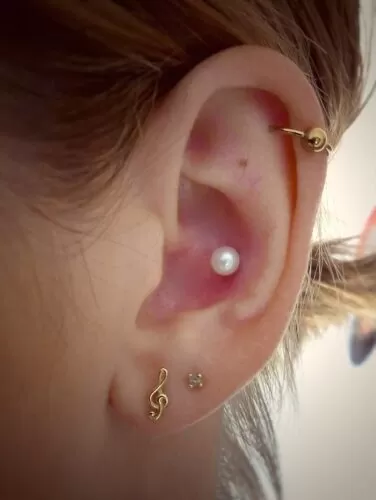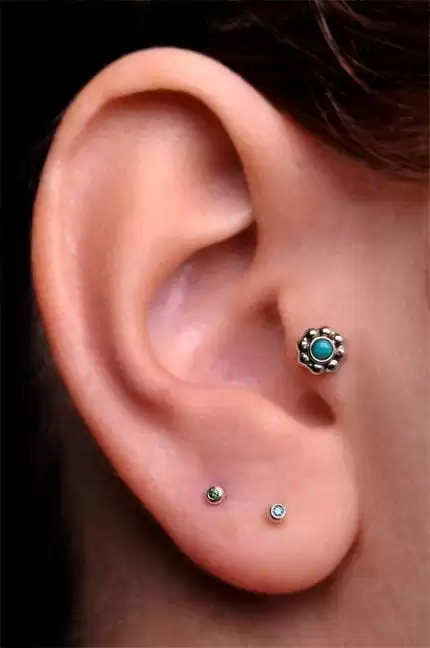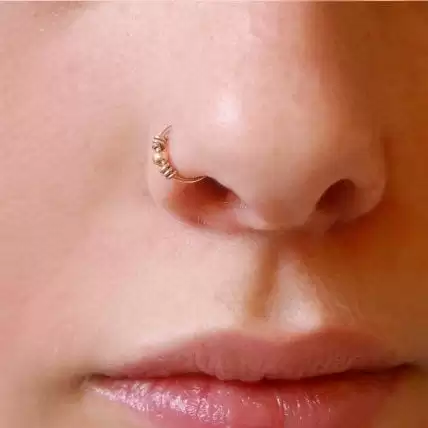As a person who loves body mods and is covered in tattoos and piercings, from simple lobe piercings all the way to surface piercings on my chest and back of my neck, I would like to think I have plenty of experience on this topic.
Lets go back for a moment, I remember my very first piercing, my lobes, I remember being terrified but plucked up the courage to get them done and afterward did not really understand why I was that scared. The same feeling goes for my first cartilage piercing which was the top of my ear. I now have eight cartilage piercings including my forward helix and tragus. Based on knowledge, facts and my own personal experience I bring you this post on all you need to know about cartilage piercings.
What Is A Cartilage Piercing and How Do You Get Them Done?
Cartilage is a flexible tissue found throughout the body and is recognised commonly in the ears and nose. A cartilage piercing is a hole punched out of the cartilage to create a hole suitable for jewellery. Before getting your new shiny piercing there are factors you MUST consider. Is your piercer a professional? More and more people now are getting piercing kits online and doing it from home and the consequences are usually finalised with an infected piercing. To avoid this, be sure to go to a professional. Is your professional using a needle or a gun? If your piercer pulls out a gun Run! Piercing guns can shatter cartilage causing more long term damage than just a hole. Make sure they use a hollow, sterilised needle for a smooth and less traumatic piercing. Is their equipment and environment safe and sterile? Make sure any needles have been opened from a vacuum packet in front of you. This way you know that the equipment has been through autoclave and is sterile. Your piercer must wear gloves to prevent any cross-contamination. It is also a good idea to have your piercing done with a bar which is longer than the width of your skin by at least 4mm (2mm on either side). This is to allow for any swelling after piercing. Although swelling should not really occur, it is always best to stay on the safe side.
Have a look at this Step by step video tutorial to see just how a helix cartilage piercing is done.
Pros And Cons of Cartilage Piercings.
Well, of course the top pro for cartilage piercings is the fashion appeal. So many people, guys and girls, have cartilage piercings now and they do look stunning. Jewelry is so vast these days with variations on studs, bars, rings, and even stretchers that there is a personal style for absolutely everyone whether you like the pink princess, shiny studs or prefer a black line tribal stretcher. Cartilage piercings can be whatever you want them to be, from simple one tone studs to multicoloured 12mm plugs. The choice is endless.
The cons of cartilage piercings are minimal, however, they can be prone to infection (same as all piercings) if not cared for properly. Please do not blame your piercer for infections if you have no looked after it yourself! Piercers can only really be blamed if they have practiced poor piercing techniques such as using dirty equipment. This is why you should have piercings done professionally and continue to look after them. If your cartilage piercing is in your ear then refrain from using hair sprays, gels and chemical products as these will irritate your fresh piercing and will prolong the healing process. As a biker girl, the only con I’ve found with ear cartilage piercings is trying to get a bike helmet on over them, but there’s a trick to it 😉
How Painful Is A Cartilage Piercing? Does it hurt ?
Well to be perfectly honest there is no definite answer to this question as everyone has a different pain threshold. It is completely down to how you can handle pain yourself. Personally, I do not find them at all painful but then my threshold is quite high. For the folks out there who are worried though, you will feel a quick, sharp pinch for a split second and that is it. You may feel a burning sensation afterward where your body is coping with the traum it has been through, although (I quite like the feel of this part) everyone is different. I promise you, cartilage piercings do not have an ongoing pain, unless you do not take care of them.
What Is The Healing Time For A Cartilage Piercing?
Although healing time varies from person to person, cartilage, helix, nose piercings can typically take anywhere between 6 – 12 months to heal properly. This is due to the cartilage becoming weak and surrounding skin becoming tender after the piercing process and will take time to regain its strength. Any cartilage piercings done with a gun will take a lot longer to heal as shattered cartilage can be very painful, will be very weak and will welcome infection with open arms so be sure to keep it clean! By the end of a year your piercing should be completely healed and you can change your jewellery and sleep on it with ease.
13 Different Types of Cartilage Piercings.
Most people just assume that cartilage piercings are the top of your ears and your nose, however, this is not so. There are many different cartilage piercings (although most of them are in your ears). I have included a list of images for you so you can see which cartilage piercing is which. This may also give you ideas on your own cartilage piercings. Why not pick out some of these piercings for yourself and discover a gorgeous cartilage piercing which suits you personally?
#13- Helix

#12- Forward Helix

#11- Conch

#10- Inner Conch

#9- Rook

#8- Orbital

#7- Tragus

#6- Anti Tragus

#5- Daith

#4- Industrial / Scaffold

#3- Nose

#2- Septum

#1- Linked Helix and Lobe Jewellery









